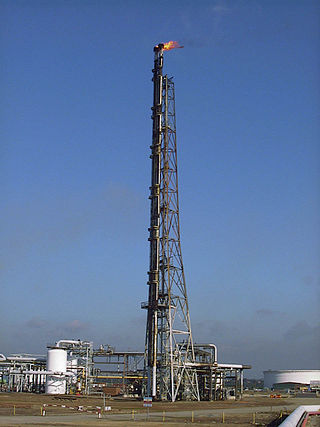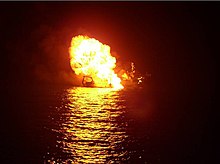
Offshore construction is the installation of structures and facilities in a marine environment, usually for the production and transmission of electricity, oil, gas and other resources. It is also called maritime engineering.

Critical infrastructure, or critical national infrastructure (CNI) in the UK, describes infrastructure considered essential by governments for the functioning of a society and economy and deserving of special protection for national security.

A gas flare, alternatively known as a flare stack,flare boom, ground flare, or flare pit is a gas combustion device used in places such as petroleum refineries, chemical plants and natural gas processing plants, oil or gas extraction sites having oil wells, gas wells, offshore oil and gas rigs and landfills.

The energy industry is the totality of all of the industries involved in the production and sale of energy, including fuel extraction, manufacturing, refining and distribution. Modern society consumes large amounts of fuel, and the energy industry is a crucial part of the infrastructure and maintenance of society in almost all countries.

In the U.S., critical infrastructure protection (CIP) is a concept that relates to the preparedness and response to serious incidents that involve the critical infrastructure of a region or the nation. The American Presidential directive PDD-63 of May 1998 set up a national program of "Critical Infrastructure Protection". In 2014 the NIST Cybersecurity Framework was published after further presidential directives.
The International Association of Oil & Gas Producers (IOGP) is the petroleum industry's global forum in which members identify and share best practices to achieve improvements in health, safety, the environment, security, social responsibility, engineering and operations.
Maritime security is concerned with the prevention of intentional damage through sabotage, subversion, or terrorism. Maritime security is one of the three basic roles of the United States Coast Guard has gradually developed in response to a series of catastrophic events, which began in 1917.

Energy security is the association between national security and the availability of natural resources for energy consumption. Access to cheaper energy has become essential to the functioning of modern economies. However, the uneven distribution of energy supplies among countries has led to significant vulnerabilities. International energy relations have contributed to the globalization of the world leading to energy security and energy vulnerability at the same time.
Subsea technology involves fully submerged ocean equipment, operations, or applications, especially when some distance offshore, in deep ocean waters, or on the seabed. The term subsea is frequently used in connection with oceanography, marine or ocean engineering, ocean exploration, remotely operated vehicle (ROVs) autonomous underwater vehicles (AUVs), submarine communications or power cables, seafloor mineral mining, oil and gas, and offshore wind power.
Process safety is an interdisciplinary engineering domain focusing on the study, prevention, and management of large-scale fires, explosions and chemical accidents in process plants or other facilities dealing with hazardous materials, such as refineries and oil and gas production installations. Thus, process safety is generally concerned with the prevention of, control of, mitigation of and recovery from unintentional hazardous materials releases that can have a serious effect to people, plant and/or the environment.

A fixed platform is a type of offshore platform used for the extraction of petroleum or gas. These platforms are built on concrete and/or steel legs anchored directly onto the seabed, supporting a deck with space for drilling rigs, production facilities and crew quarters. Such platforms are, by virtue of their immobility, designed for very long-term use. Various types of structure are used, steel jacket, concrete caisson, floating steel and even floating concrete. Steel jackets are vertical sections made of tubular steel members, and are usually piled into the seabed. Concrete caisson structures, pioneered by the Condeep concept, often have in-built oil storage in tanks below the sea surface and these tanks were often used as a flotation capability, allowing them to be built close to shore and then floated to their final position where they are sunk to the seabed. Fixed platforms are economically feasible for installation in water depths up to about 500 feet ; for deeper depths a floating production system, or a subsea pipeline to land or to shallower water depths for processing, would usually be considered.

The petroleum industry in Western Australia is the largest contributor to the country's petroleum exports. Western Australia's North West Shelf (NWS) is the primary location from which production originates. Oil exports are shipped from Port Hedland.

The oil and gas industry plays a central role in the economy of the United Kingdom. Oil and gas account for more than three-quarters of the UK's total primary energy needs. Oil provides 97 per cent of the fuel for transport, and gas is a key fuel for heating and electricity generation. Transport, heating and electricity each account for about one-third of the UK's primary energy needs. Oil and gas are also major feedstocks for the petrochemicals industries producing pharmaceuticals, plastics, cosmetics and domestic appliances.

DNV is an international accredited registrar and classification society headquartered in Høvik, Norway. The company currently has about 12,000 employees and 350 offices operating in more than 100 countries, and provides services for several industries including maritime, oil and gas, renewable energy, electrification, food and beverage, and healthcare. DNV GL was created in 2013 as a result of a merger between two leading organizations in the field — Det Norske Veritas (Norway) and Germanischer Lloyd (Germany). In 2021, DNV GL changed its name to DNV, while retaining its post-merger structure.
The Convention for the Suppression of Unlawful Acts against the Safety of Maritime Navigation or SUA Convention is a multilateral treaty by which states agree to prohibit and punish behaviour which may threaten the safety of maritime navigation.
The Protocol for the Suppression of Unlawful Acts against the Safety of Fixed Platforms Located on the Continental Shelf is a multilateral treaty by which states agree to prohibit and punish behaviour which may threaten the safety of offshore fixed platforms, including oil platforms.

The Petroleum Act 1998 is an Act of the Parliament of the United Kingdom which consolidated arrangements for the licensing, operation and abandonment of offshore installations and pipelines. As a consolidation Act, it did not change the substantive law, although certain Acts were amended and repealed.
NEMS AS is a Software Development and advisory company, which is specialized in the domain of emissions control of emissions to air and discharge to sea, as well as environmental reporting and environmental management systems (EMS). The company provides its customers with software for environmental accounting, corporate sustainability reporting and chemical management. NEMS also provides advisory services to organizations, authorities and clients. NEMS AS has previously had other names including Novatech AS and Add Novatech AS in 2008 as part of Add Energy Group.
Maritime terrorism in Southeast Asia refers to acts of extreme maritime violence committed with political motives within the Southeast Asian region. Despite seaborne terrorist attacks accounting for only 2% of all international terrorist incidents from 1978 to 2008, according to RAND's Terrorism Database, Southeast Asia has proven a hotbed of maritime terrorism. Due to the high frequency of pirates in the region, many Southeast Asian-based terrorist groups have appropriated piratical tactics in carrying out their violent political struggles. In 2003, the International Maritime Bureau reported that out of the 445 actual or attempted piratical attacks on merchant vessels, 189 occurred in Southeast Asia, which was more cases than either Africa or Latin America, with 121 attacks occurring in Indonesian waters and 35 attacks occurring in Malaysian and Singaporean waters. In 2004, while the number of actual and attempted attacks fell to 325, Southeast Asia remained at the top of the regional rankings, with 93 incidents occurring in Indonesian waters. Between 2014 and 2018, 242 attacks occurred in Southeast Asia, with the majority occurring in Indonesian waters. The most popular weapons of choice among Southeast Asian maritime terrorists have been explosive devices and firearms, which were used in roughly 60% of maritime attacks in the region.
ISO Technical Committee 67 – Oil and gas industries including lower carbon energy is a technical committee within the International Organization for Standardization (ISO). ISO/TC 67 is responsible for developing and maintaining international standards in the worldwide upstream, midstream and downstream oil and gas industry and related lower carbon energy activities. Its role encompasses the harmonisation of standards for facilities, equipment and operations used for drilling, production, pipeline transport and processing of liquids and gaseous hydrocarbons on, and between, offshore oil and gas installations and onshore terminals and oil refineries.
















